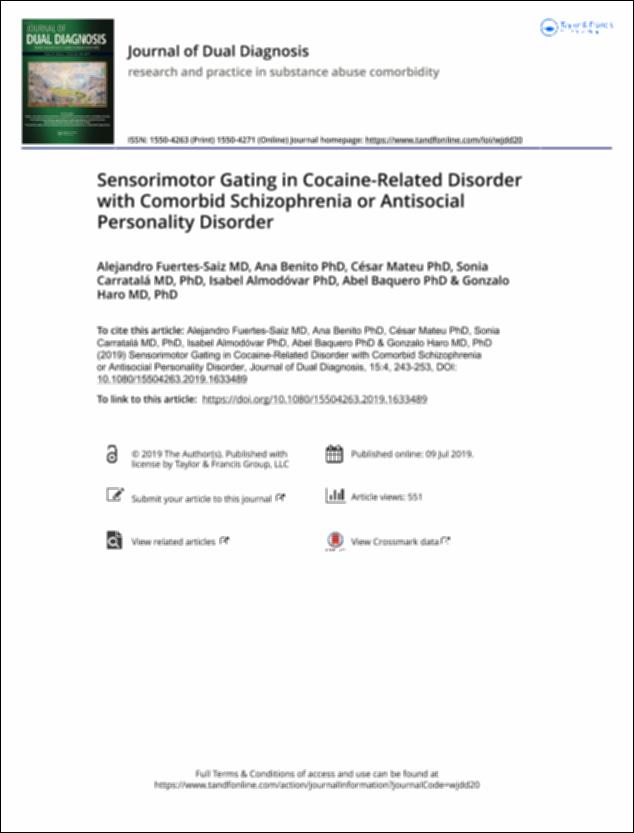Por favor, use este identificador para citar o enlazar este ítem:
http://hdl.handle.net/10637/10853Sensorimotor gating in cocaine-related disorder with comorbid schizophrenia or antisocial personality disorder
| Título : | Sensorimotor gating in cocaine-related disorder with comorbid schizophrenia or antisocial personality disorder |
| Autor : | Fuertes Saiz, Alejandro Benito Delegido, Ana Mateu Hernández, César Andrés Carratalá Monfort, Sonia Almodóvar Fernández, Isabel Baquero Escribano, Abel Haro Cortés, Gonzalo Rafael |
| Materias: | Esquizofrenia.; Neuropsiquiatría.; Neuropsychiatry.; Cocaine abuse.; Cocaína - Adicción.; Inhibition.; Personalidad - Trastornos.; Personality disorders.; Schizophrenia.; Inhibición. |
| Editorial : | Informa UK. |
| Citación : | Fuertes-Saiz, A., Benito, A., Mateu, C., Carratalá, S., Almodóvar, I., Baquero, A., et al. (2019). Sensorimotor gating in cocaine-related disorder with comorbid schizophrenia or antisocial personality disorder. Journal of Dual Diagnosis, vol. 15, n. 4, pp. 243-253 (9 jul.). DOI: https://doi.org/10.1080/15504263.2019.1633489 |
| Resumen : | Objective:Schizophrenia, cocaine-related disorder, antisocial personality disorder, andpsychopathy share biological bases, but few studies discriminate between these disordersby means of prepulse inhibition. This work studies the phenotype of patients with cocaine-related disorders who are vulnerable to presenting a dual diagnosis of schizophrenia orantisocial personality disorder, by evaluating their prepulse inhibition, impulsivity and psych-opathy personality traits.Methods:The sample (n¼38) was divided into three groups: (1)cocaine-related disorder (8 individuals diagnosed with cocaine-related disorder who did notpresent any other mental disorder), (2) cocaine-related disorder and schizophrenia (n¼14),and (3) cocaine-related disorder and antisocial personality disorder (n¼16).Results:Theprepulse inhibition in the two groups with dual diagnosis was lower than that in thecocaine-related disorder group,F(2, 35)¼6.52,p¼.004, while there was no significant differ-ences between the two dual-diagnosis groups. Psychopathy was evaluated with the revisedHare Psychopathy Checklist and showed no correlation with the prepulse inhibition.Secondary psychopathy (impulsivity and poor behavior control), as evaluated with LevensonSelf-Report Psychopathy Scale, was related to the prepulse inhibition. Two discriminating functions were obtained that allowed prediction of patient inclusion in the groups usingthe prepulse inhibition and the revised Hare Psychopathy Checklist with a success rate of81.6% (cocaine-related disorder¼62.5%; cocaine-related disorder and schizophrenia¼78.6%;cocaine-related disorder and antisocial personality disorder¼93.8%). These results are dis-cussed in regard to the neurobiological implications of prepulse inhibition in dual diagnosis.Conclusions:The results suggest that the prepulse inhibition is a promising dual-diagnosisvulnerability marker in individuals with cocaine addiction, because prepulse inhibition defi-cits are related both to schizophrenia and antisocial personality disorder. In addition, pre-pulse inhibition, which is considered a good endophenotype for studies on the genetic andneurobiological basis of cocaine-related disorder and schizophrenia, could be used in thesame way in studies on antisocial personality disorder. |
| Descripción : | Este es el artículo que se ha publicado de forma definitiva en: https://www.tandfonline.com/doi/full/10.1080/15504263.2019.1633489 |
| URI : | http://hdl.handle.net/10637/10853 |
| Derechos: | http://creativecommons.org/licenses/by-nc-nd/4.0/deed.es |
| ISSN : | 1550-4271 (Electrónico). 1550-4263 |
| Fecha de publicación : | 9-jul-2019 |
| Centro : | Universidad Cardenal Herrera-CEU |
| Aparece en las colecciones: | Dpto. Medicina y Cirugía |
Los ítems de DSpace están protegidos por copyright, con todos los derechos reservados, a menos que se indique lo contrario.


